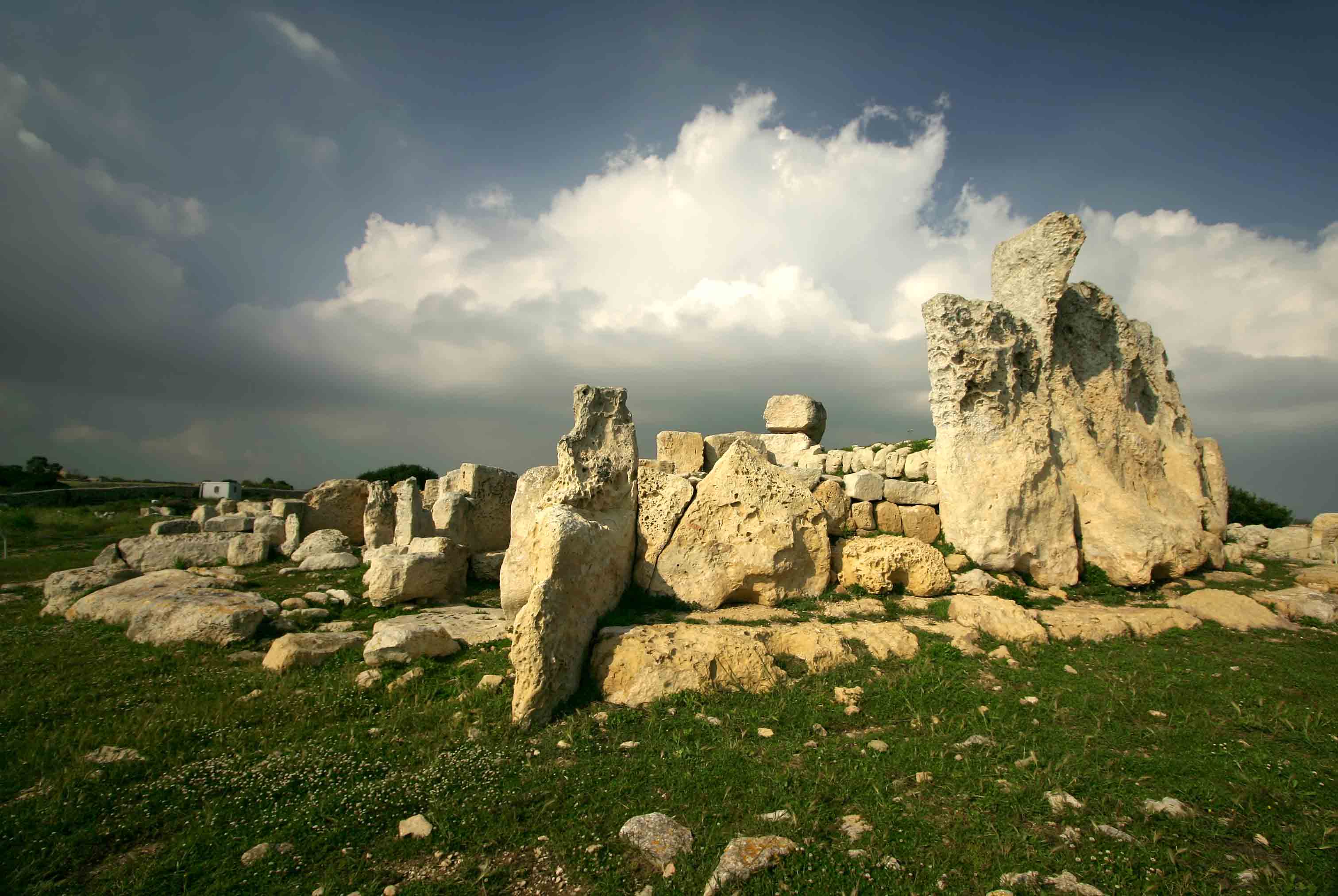Today we have another contribution from Timeless Travels Magazine. On a recent visit to Malta’s prehistoric temples, Garry Shaw endeavours to enter the minds of Malta’s temple builders, once thought to be a race of giants by the local inhabitants.
Once upon a time, Sansuna, a giantess on the island of Gozo, went to the town of Ta’ Cenc, placed huge stones upon one of her shoulders and carried them 4 km to their current resting place at Ġgantija, “the Place of Giants”. A multi-tasker, she did this while holding her half-giant, half-human baby over the other shoulder. Taking these heavy stones, she then built the temple complex of Ġgantija and afterwards allowed the local people to worship within. More unusually, and perhaps irrelevant to the story (but hey, it’s often the little details that make a tale believable), she lived exclusively on broad beans and honey (though some versions replace the honey with water). As old legends go, it’s an entertaining one but it’s not the only explanation for Ġgantija’s megalithic prehistoric temple complex. I had also read that it had served as a defensive tower, again built by a race of giants (naturally).
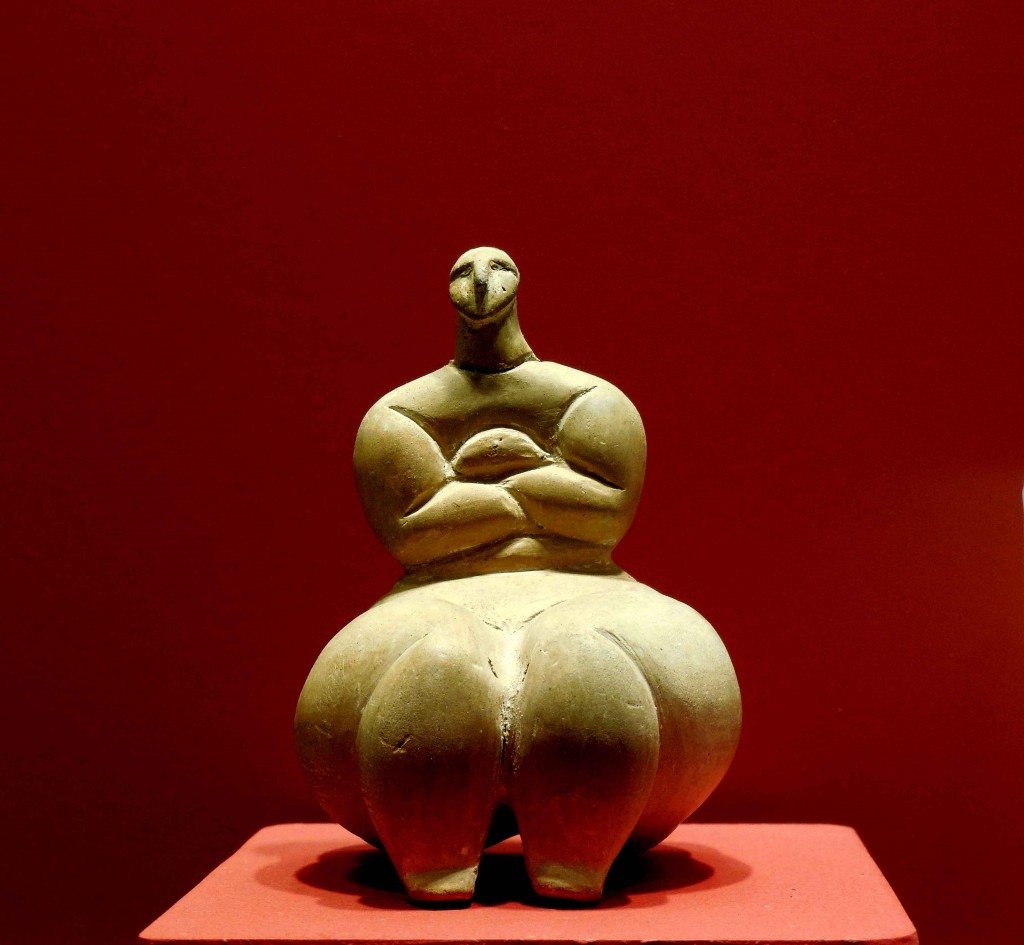
Figure from Zaghra Circle, on display at Ggantija Museum. Photo © Garry Shaw.
Entering the Ġgantija archaeological site in Gozo, Malta’s sister island, I could immediately see why such legends had evolved. Approaching the temple from the rear along a modern walkway, the path alive with brightly coloured flowers, an enormous wall of grey interlocking monoliths, some weighing at least 20 tonnes, rose into view. Its lower course was formed of imposing vertical standing stones, while above, its upper levels were laid out horizontally. Taken together, it looked like an ancient game of giant Jenga, 6m tall, or perhaps a rapidly failing game of Tetris. Many of the monoliths were mottled by weathering as if they had been briefly dipped in sulphuric acid. Tufts of green grass protruded from the gaps between stones. Scholars, discounting the possibility of a giant-enhanced workforce, have estimated that 50 men were needed to erect a single one of these exterior megaliths and that the entire temple took around 30,372 days to construct. To add to its complexity, though appearing to mark a single building, this great wall is actually a D-shaped enclosure that encompasses two separate temples to the north and south, each with its own entrance from a common forecourt. It was a temple complex rather than a single building and it had rested on this spot since around 3500 BCE.
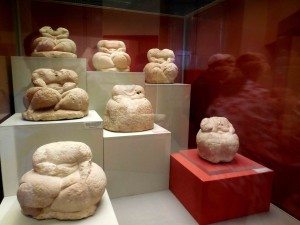
Cache of figures from Hagar Qim. Photo © Garry Shaw.
Taking the South Temple first, I walked down a central corridor flanked by four oval chambers (referred to as “apses” by scholars), two to each side. These led directly to a fifth apse at its far end, giving the entire arrangement the slight appearance of a shamrock. The walls stood tall above me, unchanged in thousands of years, though their rough appearance was once smoothed by plaster. During excavations, archaeologists had found ritual furniture in one of the South Temple’s apses, including altars decorated with spirals but now heavily weathered. In the similarly designed but smaller North Temple, the entrance was originally very low, forcing visitors to crouch down as they entered, a feature bound to please the vertically challenged but surely with a greater purpose. As I explored, all I could think was: what was the meaning behind these curious features?
Luckily, my wanderings at Ġgantija were accompanied by Daphne Caruana, curator of Gozo’s sites and Vince DeBono, my expert guide for the duration of my time in Malta. After viewing the temple complex we headed into Ġgantija’s modern visitor centre where we came into the presence of some of Malta’s famous “corpulent anthropomorphic figures”, as the more scholarly literature calls them, or “fat ladies” as they are more popularly known. One obese figurine clutched her stomach, her prominent nose and eyes turned upwards to the sky. Another sat placidly, fat fingers locked in contemplation, resting on round thighs twice as big as her upper body. Her head was missing.
Close by was a single statuette depicting twin corpulent figures seated side by side on a couch, one holding a tiny representation of an equally corpulent individual. It had been excavated at the Xagħra Circle, a burial site close to Ġgantija. “This is a very significant artefact,” said Daphne. I brought my face closer to the glass. Their pleated kilts formed an almost unbroken chain and as with the other figures nearby, their arms rested on chubby legs. Unlike the others, however, their lower legs and feet had been painted with red ochre. “As it’s prehistory and we have no written records, it’s very difficult to say what the artist or sculptor intended”, said Daphne. “What we can see for sure is the high level of artistry behind it. It’s quite exceptional.” I agreed, and asked why the figures were carved so plump. “This is very typical of the body shape that we find in Maltese Neolithic statuary”, she replied. “For a long time it was interpreted as the mother goddess but we’d like to go a bit beyond that. In fact it’s quite clear that, for example, this particular piece is very intentionally genderless. So it’s either male or female. But there is a lot of emphasis on showing the corpulent lower body part. And that, I think, can very easily signify well-being.” In prehistoric Malta, when resources were limited, I could certainly see how fat equalled prosperity.

This article was originally published in Timeless Travels magazine. Republished with permission.
Other objects were even harder to interpret. From the Xagħra Circle, a group of paddle-shaped figurines, each armless and legless and bound together when interred, had been unearthed. These had been designed to be held (they cannot stand on their own) and some had been purposely left unfinished. Because some are more complete than others, Daphne suggested that they might represent “the cycle of life, the idea of starting with nothing and then developing”. But as she had earlier warned me, “the figurines are so heavy with symbolism that you can’t really just give a solid meaning and interpretation to what they could actually signify.” As we talked, questions filling my mind, I wanted to discover more about Ġgantija’s place in the development of Maltese prehistoric beliefs. And if possible, I also wanted to better understand the mind of the Maltese temple builders themselves. It was time to explore further.
Beginnings: Għar Dalam and Skorba
The next day Vince took me to Għar Dalam, “the Cave of Darkness”, a horizontal cut through the earth formed by flowing water in the distant past. Beside the cave’s entrance, a rock with a large hole at its centre was surrounded by a chain cordon, hung with a sign saying ‘Do not be afraid of the bees they are harmless’. A picture of a friendly bee reinforced the laminated page’s point. As I peered into the cave, down a set of steps there was a loud buzzing sound like orchestral strings building tension in a horror movie. I quickly realised that the bees lived everywhere in holes in the ground. I trod carefully as I entered, afraid of disturbing them.
About 7,000 years before my visit, Għar Dalam was used as a shelter by Malta’s earliest inhabitants. Settlers from Sicily had braved the sea, probably clutching a few possessions (and certainly their distinctive pottery) whilst bobbing around in their boats, ready to start a new life on the island. Upon arrival they had founded settlements, with one group choosing Għar Dalam as their home, the cave providing protection from the elements whenever more extreme conditions hit. I peered into the gloom, the cave’s length illuminated by artificial light and tried to imagine groups of families huddling together in the twilight, adjusting to their new lives on the uninhabited island. Like me, they would have heard the gentle plip-plopping of water from stalactites and perhaps noticed the slow formation of stalagmites from the pools of creamy water below. Surrounded entirely by stone, protected and safe, I wondered if the first spark of monumental temple building had entered the mind of a person crouching in this very cave seven millennia ago.
As I looked out, I tried to replace in my eyes the modern houses and churches with Neolithic farms and wooden villages.
While one group of early settlers occupied Għar Dalam, another was living at Skorba, on the opposite side of Malta to the northwest. But unlike those at Għar Dalam, they had continued to live there for over a thousand years afterwards. As we drove across the island, along roads winding between green hills, Vince suggested that I try to picture the surrounding landscape as an ancient hive of activity. “The Prehistoric people couldn’t use the steeper parts of Malta’s hills because the soil wouldn’t hold, but down below, it was perfect,” he said. As I looked out, I tried to replace in my eyes the modern houses and churches with Neolithic farms and wooden villages. But the frequent sight of pastizzi shops, all selling Malta’s national dish of hot pastries filled with either ricotta cheese or mushy peas, led to hunger breaking my concentration.
Arriving at Skorba, Vince took me to two adjoining stone-lined ovals in the ground protected by a single strand of wobbly, green barbed wire, just outside the archaeological site’s fence. Grass grew all around. There was a bush and some cacti nearby. “These are some of the most important monuments on the island”, Vince said pointing to the ovals, “there’s very little evidence of settlement remains from this early phase of Maltese history.” I stared down into the shallow pits. Archaeologists had found goat skulls and pottery figurines within – the oldest human figures known on the island – and due to the lack of a hearth some had interpreted them not as domestic huts but as shrines, the first manifestation of the island’s grand temples, and a reminder of their humble and certainly less effort-intensive, origins. They dated to a period known as the Red Skorba phase, approximately 4400-4100 BCE, just before Malta’s first rock cut tombs were made and about 500 years before the first megalithic temples.
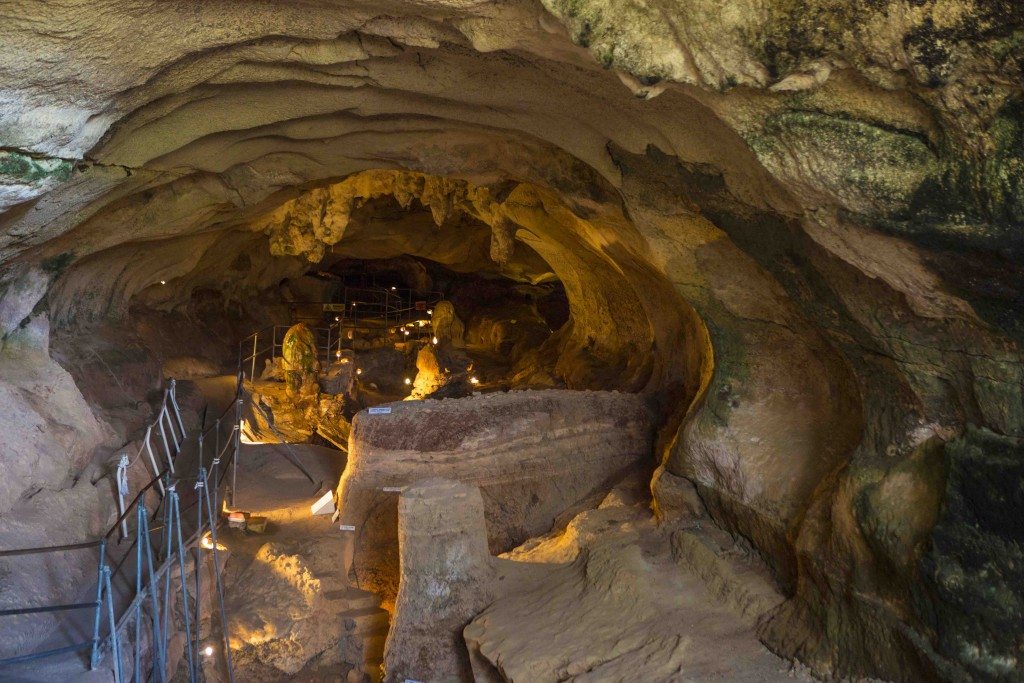
Inside the cave at Ghar Dalam. Photo © ViewingMalta.com, Aaron Briffa.
Over time Skorba continued to develop until the village had its own megalithic temple. Entering the archaeological site proper, Vince took me to stand in front of a few giant standing stones. “This is a Mark One temple,” he said. “It’s one of the early versions of this type of temple from around 3600 BCE.” This placed its construction at about the same time as Ġgantija on Gozo. Most of the temple blocks stood only a few courses high though the occasional standing monolith, heavily eroded, observed my movements. I could just about make out the shape of the oval apses and pitted decoration, the same as I had seen on Gozo. Even at this early time a standard plan was developing, one that would only grow more complex with time.
Conservation at Ħaġar Qim
Later that day Vince and I moved on to Ħaġar Qim, a temple constructed between 3600 and 3200 BCE, contemporary with Ġgantija, where a large cache of the so-called “fat lady” statues had been found. As I walked along the stark hilltop towards the temple – one of the island’s best preserved examples – birds chirped and bees buzzed. There was the smell of thyme in the air. A cold breeze touched the back of my neck. Aniseed and red clover grew all around beside the path. And in the distance, a giant white UFO hovered over the temple.
I must admit, upon closer inspection, the UFO turned out to be a protective shelter – a giant tent – held in the air by steel-supports. Though controversial, this shelter, erected in 2010, adds an attractive otherworldliness to the temple’s already stark and beautiful setting and serves an important function at the same time: it will give the temple a 25-year reprieve from erosion while conservators develop new materials to protect the stones. Since being excavated in the 19th century, temperature fluctuations had caused the ancient blocks to crack. Malta’s rainy seasons had also weakened them, leading to repeated collapses. This shelter, I was later told, keeps the stones from overheating during the day and from overcooling during the night, preventing internal strains from developing. Just like nearby Mnajdra Temple, also covered by a shelter, Ħaġar Qim is now, visually and symbolically, being swallowed by the modern age and all efforts are being taken to save it.

View of Temple of Hagar Qim. Photo © ViewingMalta.com.
Entering the shelter, I soon became lost in the temple’s corridors and apses. The tent tempered the intense sunlight outside. I was surrounded by hues of beige and the smell of warm dust. Many blocks were randomly pierced by honeycombs of tiny, round eroded holes, like spots on a leopard. Quite unusually stone benches ran around the temple’s exterior. “They could be reinforcement ribs, helping to keep the ceiling in place”, Vince said. “Another idea is that they were a place for important people to meet.” Some of the giant stone blocks had been pierced by rectangular doorways; these ‘portholes’, as they are known, allow entry into the temple’s apses, otherwise screened off by thin slabs, and force you to simultaneously lower your head and step high to pass through them. At one point, a hole too small to be a ‘porthole’, also penetrated one of the megalithic slabs; though often referred to as an ‘oracle hole’ or a ‘birthing hole’, in reality no one knows what the ancient architect had in mind here. Some suggest that the sun once shone through on the summer solstice. Others say that it was meant to enhance sounds. Some see astronomical significance. They are all probably wrong. One thing was clear though: these were complex buildings. And as I was soon to learn, the word “temple” doesn’t do them justice.
Endings: Tarxien Temple
“Tarxien Temple is the Henry Ford conveyor-belt style of temple”, said Vince as we parked beside a tall wall at the centre of a deserted town. Built in around 3300 BCE and representing the final phase of temple building on the island, by the time Tarxien came into existence the Maltese had become masters of temple construction and given the time and resources, probably could have mass produced them just like Henry Ford had done with his cars.
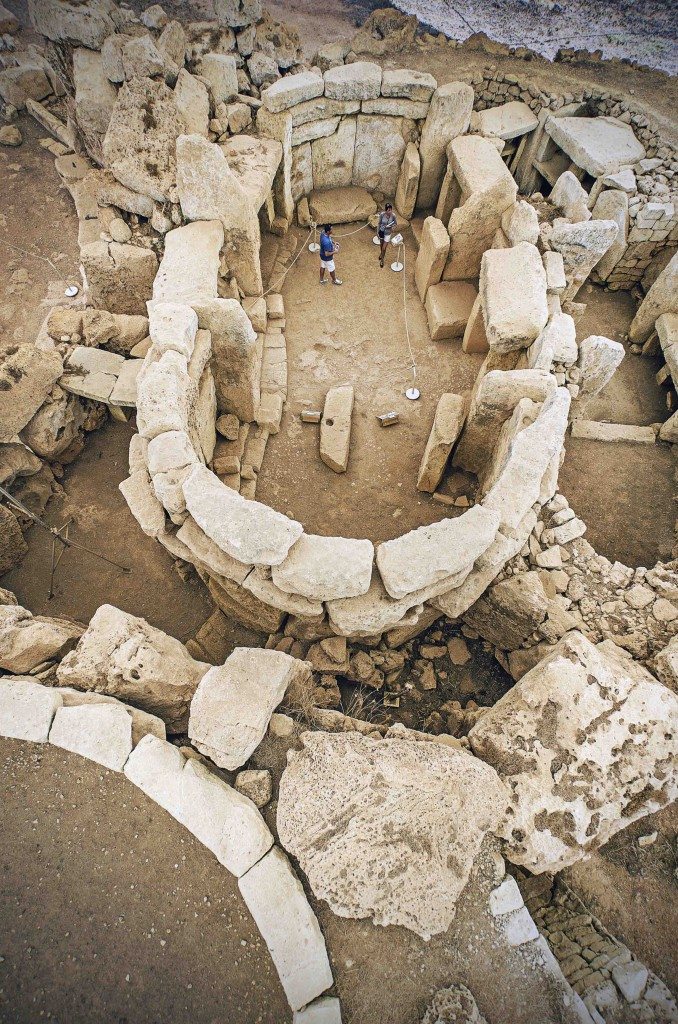
Temple of Hagar Qim from above. Photo © ViewingMalta.com.
And it’s clear that at Tarxien, the builders were showing off this expertise. It’s the most complicated of Malta’s ancient complexes with four connected temples, one with as many as six apses. And though much of the site still remains to be uncovered, out of Malta’s over 30 megalithic temples, the largest collection of stone sculptures has already been discovered here including a colossal figure, originally about 2 to 3 metres tall, wearing a skirt or kilt, with bulbous thighs leading to tiny feet. An eroded round block found nearby may once have been its head. During my visit the only people digging were making holes on the edge of the site for the foundations of a shelter, similar to the one around Ħaġar Qim, as part of ongoing efforts to protect the site. Walking in the sunshine, feeling the heat on my face, it crossed my mind that I would be among the last to see the temple uncovered for the next 25 to 30 years.
With a modern raised walkway, a cemetery next door and apartment buildings overlooking the ancient temples, Tarxien felt less isolated than any of the previous sites I had visited. Replica sculptures stood on the spots where the originals (now in Valletta) had been found. Modern interpretation panels told the site’s story and even included sections for children. As I stood on the walkway looking down, vivid green grass topped the fill between the grey slabs of the ancient enclosure wall and the temple’s chambers, making the overall plan more striking and easier to envision than at other sites. A ginger and white cat nonchalantly made its way across the blocks, perhaps charged with protecting the remains from rodent vandals.
At the visitor centre Vince and I met Katya Stroud, senior curator of prehistoric sites. As we strolled through the temple’s now familiar arrangement of apses and corridors, I asked her about the curious “portholes” and partitions I had seen at Ħaġar Qim. “The architecture itself is very controlling, physically and visually”, she said. “If you’re standing at one end of a corridor you can’t see what’s happening in the side chambers. Sometimes this is even emphasised more by having little screens or partitions placed at the entrance of the chambers. Apart from that, at times you have physical barriers from entering an area.” I was intrigued and asked her to explain further. “Here at Tarxien, in one doorway there’s a ledge that you have to climb over to gain access to further spaces. In other areas you have doorways that are very low. They’ve been cut out of one whole stone slab, like a hole punctured through and you have to squeeze through. Most of the time you have to bend your head and lift yours legs and you literally have to squeeze through to get into a space.”
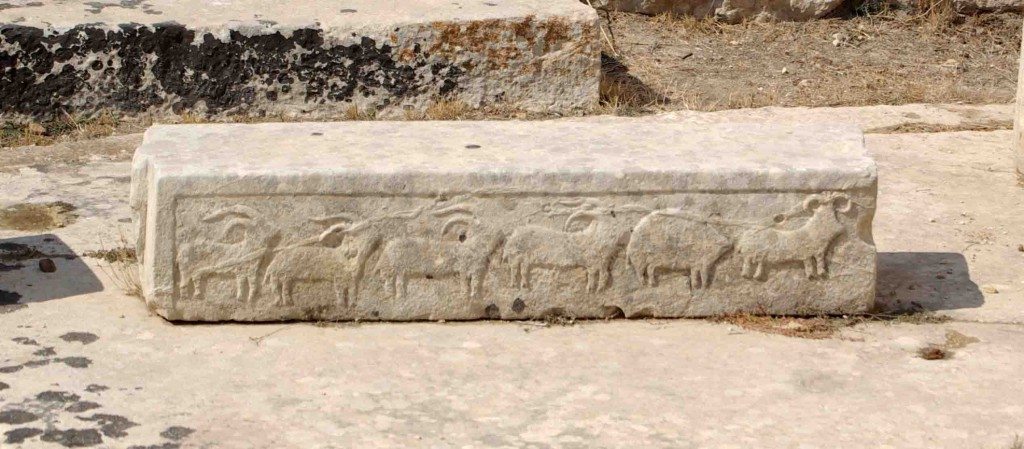
Relieft showing goats and rams from one of the temples at Tarzien. Photo © Berthold Werner, CC-BY-SA 3.0.
After days of exploring the Maltese islands, I felt that I was finally starting to tune into the Neolithic mind. From what I now understood, to the temple builders a threshold was not just a space between inside and outside; the physical act of stepping up, or crouching down forced a mental shift of gear from normality to difference. Such transition points must have had a strong impact on those passing from their everyday environment – the heat of the sun, the noise and bustle of the village, the familiar sight of figs, olive trees, wheat and barley, the smell of thyme in the air – into the confined darkness of the temple.
But despite the obvious barriers created by the architecture, Katya explained that entry into the temple area was perhaps not as restricted as I had assumed. As the temple builders lived at a time when there was seemingly no distinction between economic, political, and religious activities, “it would make sense to have one building that would bring all the community together for these important activities”, she told me. “When we say ‘temples,’ you have to keep in mind that they accommodated rituals related to all aspects of community life, not just religion itself. Mounds and mounds of animal bones were found here. At first people thought they were sacrifices to the gods, but actually when you think about it, whenever a community comes together even today, you have food. On Malta, resources are always limited. So you’re not going to kill a cow only for the gods. You’re not going to let it go to waste. So there must have been a lot of feasting going on and the sharing of food. Within domestic huts you never find a lot of cow bones, you always find bones belonging to the smaller animals – goats and sheep.” Perhaps reflective of the population’s love of communal feasting, carvings of goats, rams, and pigs were discovered at Tarxien while an altar block, decorated with spiral motifs, was found to contain a small “drawer” that when opened contained a flint knife; as animal bones were found nearby some see it as evidence of animal sacrifice.
But however the temple builders lived, whatever they believed (and these beliefs might have changed over time anyway) and whatever function the temples served in around 2400 BCE, the communal feasting ended, the temples were abandoned, plump figurines were no longer carved and the villagers seemingly vanished. Why, nobody knows. The only thing that’s clear is that around this time, a new Bronze Age population appeared.
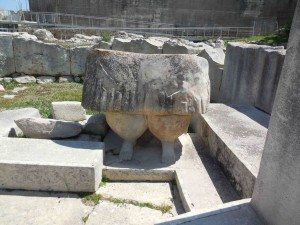
Colossal statue from Tarzien temple. Photo © Garry Shaw.
As we drove to the airport, I asked Vince what he thought about the fate of the temple builders. “It seems the island was abandoned by the Stone Age people”, he said. “Or perhaps the Stone Age people and the Bronze Age group met and diseases spread. Or maybe warfare led to the end of the Stone Age people. There is still about a 200-300 year gap in our knowledge for this period that needs explaining. Whatever the case, modern Maltese can’t say that my great, great grandfather made this sculpture.” He paused for a moment as we reached the departures terminal, “Perhaps the Bronze Age people came by Ryanair.” It’s striking to think that on this small group of islands over 5,000 years ago people had been motivated, for whatever reason, to build such massive monuments and to create such remarkable and timeless pieces of art. Although sadly there appears to have been no legendary giants involved, there was certainly ambition on a grand scale. And so from this perspective, perhaps the islands’ giants are not the stuff of legend. Perhaps Malta’s true giants were its Neolithic people.
About the Author
